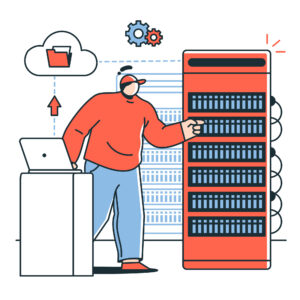Data centers are the backbone of modern businesses, powering almost everything from customer transactions to internal operations. But what happens when they go down? Downtime, this is the period when a data center can’t function, posing severe challenges to operations. In recent years, the cost and consequences of downtime to businesses have become increasingly significant. According to recent studies, the average financial cost of data center downtime is at a staggering $9,000 per minute. While the immediate financial losses are alarming, the hidden costs of downtime can be even more devastating.
When a data center goes down, the most obvious cost is the direct financial loss. This loss includes:
Lost Revenue: Every minute of downtime means lost revenue for businesses, especially those relying on real-time transactions. According to the Uptime Institute’s Annual Outages Analysis 2023, 70 percent of data center outage incidents cost businesses over $100,000 or more, with 25 percent costing more than $1 million per hour.
SLA Penalties: For business that has service-level agreements (SLAs) with clients, downtime can result in hefty penalties. Forbes Tech Council notes in a recent report that SLA violations can cost businesses up to 20% of their annual contract value.
Recovery Expenses: Restoring systems, replacing hardware, and addressing the root cause of the outage can be costly. And the recovery costs can account for 30-40% of the total downtime expense.
While these costs are significant, they only scratch the surface of the true impact of downtime.
What Is Not Seen Can Hurt Badly
Most times, the hidden costs of downtime often go unnoticed, but they always have long-lasting effects on businesses. Here are what you need to know about the hidden costs:
Operational Disruptions
Downtime does not just stop revenue—it disrupts your entire operation. The results which include delays in production, supply chain interruptions, and missed deadlines create a domino effect, which then impacts the ability to deliver products or services on time. Operational disruptions can lead to a significant drop in productivity, further compounding the immediate losses.
Employee Productivity Loss
When the systems are down, it becomes difficult or even impossible for employees to work. Leading to wasted work hours, decreased morale, and a loss of productivity that can take days or even weeks to recover from.
Reputational Damage
In today’s digital age, customers expect seamless service. So even a little glitch can lead to negative reviews, social media backlash, and a loss of trust that can damage a company brand’s reputation for years.
Compliance and Legal Risks
For businesses in regulated industries, downtime can result in compliance violations, fines, or even lawsuits—especially if sensitive data is compromised during the outage.
Opportunity Costs
Sometimes, downtime will not just cost an immediate financial loss, it costs potential growth opportunities. Missed business deals, stalled innovation, and delayed market entry can put a company behind its competitors.
These hidden costs usually linger long after the downtime is resolved, making downtime prevention a critical priority.
Root Causes and Proactive Solutions

Understanding why downtime happens is the first step toward preventing it. The common causes of data center downtime include:
Hardware Failures: Many times, downtime incidents are caused by hardware failures. An aged or faulty equipment can lead to unexpected outages.
Human Error: Mistakes during maintenance or upgrades processes can cause system failures in data centers.
Cyberattacks: Ransomware, DDoS attacks, and other threats can lead to downtime incidence, taking data centers offline.
Natural Disasters: Floods, fires, and power outages can also disrupt the data center operations.
To minimize downtime risks, consider these proactive measures:
Implement Robust Monitoring: Real-time monitoring helps to detect and address issues before they escalate. This can include AI-driven monitoring tools for predictive maintenance.
Invest in Redundancy: Investing in backup systems and failover solutions ensure continuity during an outage, protecting critical systems.
Partner with Experts: Partnering with a reliable data center support provider helps in maintaining uptime and quickly resolve issues. With dedicated expert personnels providing real-time monitoring and maintenance.
Preventing downtime requires more than just technology—it requires expertise. A professional data center support team providing data centers with:
- 24/7 Monitoring: Continuous oversight to catch potential issues early.
- Rapid Response Times: Quick resolution of problems to minimize downtime.
- Proactive Maintenance: Regular updates and maintenance to prevent failures before they occur.
By outsourcing your data center support, you can focus on growing your business while leaving the technical details to the experts.
To conclude, data center downtime is more than just an inconvenience—it’s a serious threat to businesses. The hidden costs, from operational disruptions to reputational damages have long-lasting effects and impacts that go far beyond the immediate financial losses.
But, Voila! Good news!
Downtime is preventable. By understanding the risks and investing in proactive solutions, you are protecting your business and ensuring uninterrupted operations.
Book a free Discovery Call with Heunets to evaluate your data center’s downtime risks and learn how our data center support services can keep your operations running smoothly.
Don’t let downtime cripple your business—take action today!

